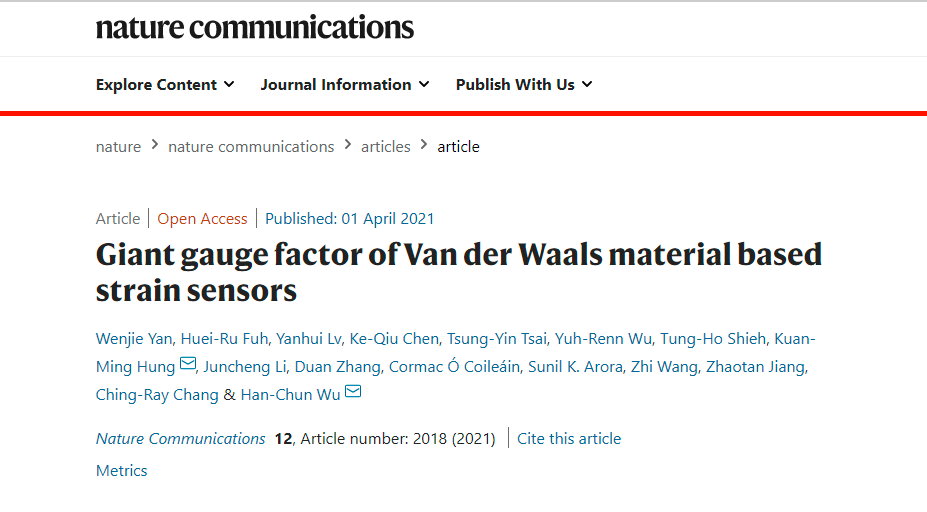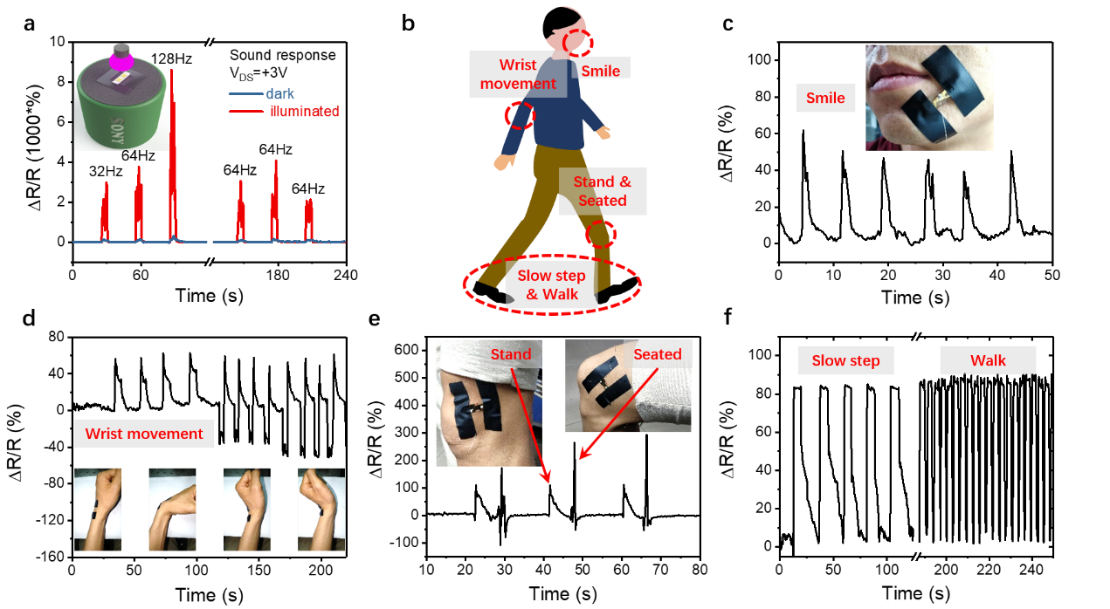Research team from School of Physics made progress in flexible electronics and wearable health care devices
来源: 作者: 发布时间:2022-05-26
Recently, Professor Han-Chun Wu, Associated Professor Zhi Wang, and Professor Zhaotan Jiang from School of Physics, Beijing Institute of Technology, developed a method to improve the Gauge factor of strain sensors by using Van der Waals layered materials, which increased the sensitivity by at least 500 times compared with metal materials. By using the mutual interaction of the piezoelectric effect and the photoelectric effect, in addition to the improvement of the Gauge factor, the adjustable range of the Gauge factor is also improved, and it specifically demonstrates its application in the daily activities of the human body to capture small vibration perception. There are important contributions to the principles and applications of learning. The innovative result “Giant Gauge factor of Van der Waals material based strain sensors” was published in Nature Communications on April 1st.
In recent years, software robots, remote monitoring, artificial intelligence, and wearable medical instruments have developed rapidly, and there are higher requirements for the flexibility, sensitivity, and low power consumption of the corresponding sensor. Currently, commercial strain sensors are mainly based on metal materials. However, metal has no energy gap, so the gauge factor of a metal strain sensor is generally limited to a small range of 1-5. Although the energy gap strain of traditional semiconductors is adjustable, traditional semiconductor materials are usually very brittle, which also limits the strain detection range of wearable devices. Compared with metal materials and traditional semiconductor materials, Van der Waals layered semiconductor materials have excellent flexibility, optoelectronic properties and piezoelectric properties, and have huge application prospects in energy storage, optoelectronics, sensing, and wearable devices. Based on this, this cross-international and cross-field team proposed a flexible strain sensor based on Van der Waals layered semiconductor materials. Through the mutual interaction of the piezoelectric effect and the photoelectric effect to adjust the concentration and mobility of carriers, it is the first time that the gauge factor can be continuously adjusted in the range of 23-3933. In addition, as shown in the figure below, the Van der Waals flexible sensor can detect tiny vibrations caused by sound and monitor daily human activities, fully demonstrating its potential applications in robotics, remote monitoring, artificial intelligence, and wearable medical care. prospect.

Figure 1. Demonstration of real world application of Van der Waals layered semiconductor materials based strain sensor.
Yan Wenjie, a PhD student from school of physics, is the first author of this work. Professor Han-Chun Wu and Professor Kuan-Ming Hung are the corresponding authors. Prof. Ching-Ray Chang and Prof. Yuh-Renn Wu from National Taiwan University, Prof. Keqiu Chen from Hunan University, and Prof. Sunil K. Arora from Panjab University, India, participated in this international collaborated research. This work has been supported by the National Natural Science Foundation of China, the national key R & D program, and the science and technology innovation program of Beijing University of technology.
Information of the paper:
Wenjie Yan, Huei-Ru Fuh, Yanhui Lv, Ke-Qiu Chen, Tsung-Yin Tsai, Yuh-Renn Wu, Tung-Ho Shieh, Kuan-Ming Hung*, Juncheng Li, Duan Zhang, Cormac Ó Coileáin, Sunil K. Arora, Zhi Wang, Zhaotan Jiang, Ching-Ray Chang, and Han-Chun Wu*,“Giant Gauge factor of Van der Waals material based strain sensors”, Nature Communications 12, 2018 (2021).
https://www.nature.com/articles/s41467-021-22316-8




